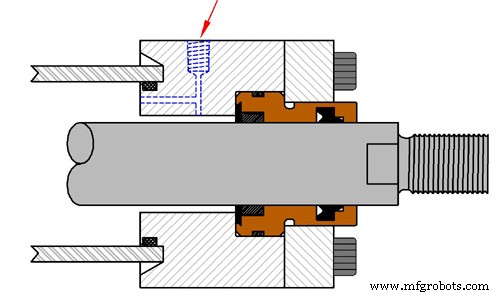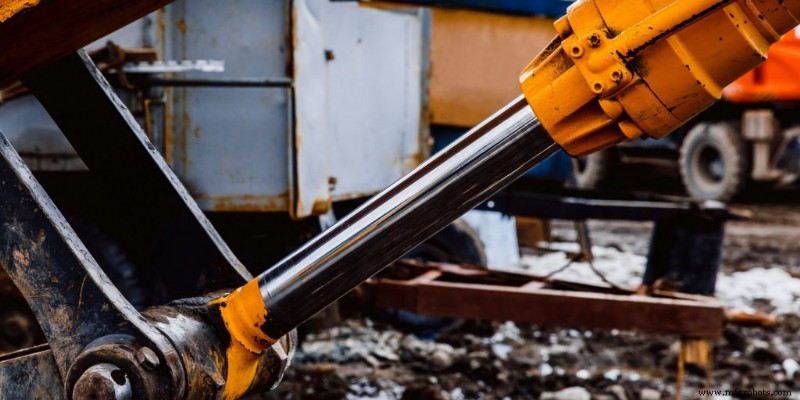산업용 장비








많은 사람들은 블리딩 유압 실린더가 무언가 잘못되어 펌프가 시동되지 않을 때만 필요한 작업이라고 생각합니다. 그러나 이것이 정말 사실입니까? 이 기사에서는 유압 실린더의 공기를 빼야 하는 이유와 그 절차에 대해 살펴보겠습니다.
유압 실린더는 항공기, 자동차 및 농업 기계를 포함한 많은 응용 분야에서 사용됩니다. 액체나 기체에 압력을 가해 움직임을 만드는 일련의 상호 연결된 튜브로 구성되어 있습니다.
유압 실린더는 일반적으로 펌프, 팬 및 모터와 같은 장치에 전원을 공급하는 데 사용됩니다. 제어된 방식으로 물체나 유체를 이동하는 데 사용할 수도 있습니다.
유압 실린더는 다양한 크기와 모양으로 제공됩니다. 그들은 종종 금속이나 플라스틱으로 만들어집니다. 단일 또는 다중 실린더 장치일 수 있습니다.
유압 실린더에 문제가 있는 경우 블리드하는 것이 중요합니다. 실린더의 공기를 빼면 피스톤과 밸브를 막을 수 있는 이물질을 제거하고 실린더를 작동 상태로 복원할 수 있습니다.

블리딩 유압 실린더는 장비를 유지 관리하고 원활한 작동을 유지하는 데 중요한 부분입니다. 블리딩 유압 실린더에는 몇 가지 유형이 있으므로 어떤 유형의 블리딩이 필요한지 아는 것이 중요합니다.
블리딩 유압 실린더의 가장 일반적인 유형은 주사기 유형입니다. 이 유형의 실린더에는 기계의 피팅 내부에 맞는 플런저가 있습니다. 플런저가 위아래로 밀리고 바닥에 도달하면 유체가 피팅을 통해 지면으로 밀려납니다. This type of cylinder can be bled using a pressure bleeder or a vacuum bleeder.
The pressure bleeder uses air pressure to push the fluid out. To use this type of bleeder, you first need to raise the pressure in the machine by turning up the gas or oil valves. Then, connect the bleeder tube to the fitting on the machine and open the bleed valve. Next, pressurize the bleeder tube by pumping air into it until the gauge reads 100 psi (pounds per square inch). Finally, close the bleed valve and wait until the gauge reads 0 psi before releasing the air pressure.
The vacuum bleeder uses suction to push the fluid out. To
Most hydraulic systems use pressurized hydraulic fluid to operate the machinery. The hydraulic pressure is created when the liquid is forced through a valve and into a pipe. When the system needs to be repaired, it’s often necessary to bleed the hydraulic cylinders by draining off the pressure.
Bleeding the cylinders allows air and other contaminants to escape and prevents them from building up, potentially causing damage to the equipment or even a fire. It’s also important to bleed the cylinders regularly if you’re using synthetic oil or any other type of lubricant, as these will add volatility and pressure to the system.
There are a few risks to bleeding hydraulic cylinders, but they are generally quite low. One potential risk is that the cylinder could rupture, resulting in severe injuries. Another risk is that the fluid could come out in a harmful or explosive manner. In either case, however, the likelihood of these risks occurring is very low.
Bleeding hydraulic cylinders is an important step in maintaining hydraulic system performance. This procedure cleans and lubricates the components and helps prevent corrosion. To bleed a cylinder, you will need the following supplies:
-Cylinder
-Bleed screw
-Locknut
-Wrench
-Hose clamp
-Hydraulic fluid
-Container to store fluid (optional)
To bleed a cylinder, start by attaching the bleed screw to the cylinder head. Tighten the locknut until the bleeding is complete. If you are using a container to store fluid, attach the hose clamp to the container and connect it to the bleed screw. Turn on the hydraulic fluid and wait for the cylinder to fill with fluid. Once it has filled, turn off the hydraulic fluid and remove the bleed screw.
If you are seeing hydraulic fluid leaking from your hydraulic cylinder, it is most likely time to bleed the system. Here are four reasons you may need to bleed a hydraulic cylinder:
-A bypass valve has been opened inadvertently, allowing fluid to escape from the cylinder and into the system.
-The cylinder seal has failed, allowing air and fluid to mix and create leaks.
-The piston has become stuck in the cylinder, preventing it from moving and creating a pressure build-up.
-The hydraulic system has been damaged in some way and needs to be repaired or replaced.

There are a few things to keep in mind when bleeding hydraulic cylinders. The first is the type of cylinder you have. There are three types of hydraulic cylinders- internal, external, and mixed. Each has its own specificBleed procedure.
Internal cylinders can only be bled through the Schrader valve on the side of the cylinder. External cylinders have a bleed port on one end that can be used to bleed them, and they also have a Schrader valve on the other end. Mixed cylinders have both types of valves- one on each end.
The next thing to consider is the pressure rating of the cylinder. Most industrial applications require a pressure rating of at least 300 psi. If you’re not sure what your pressure rating is, check with your manufacturer or look it up online.
Now that you know some basics about bleeding hydraulic cylinders, it’s time to get started! Here’s a step-by-step guide to bleeding an internal cylinder:
1) Turn off the power to the machine and remove any stray objects that could get caught in the machinery.
2) Open the bleed port on the side of the cylinder (if applicable) and insert a suitable tube into
Bleeding hydraulic cylinders is a necessary task to keep your equipment in working order. However, it can be an extremely challenging and time-consuming process. In this article, we will discuss the different methods that are available for bleeding hydraulic cylinders and provide you with tips on how to successfully execute the task. We hope that this article will help make bleeding hydraulic cylinders a little bit easier for you.
Do you need to bleed hydraulic cylinders,please click topkitparts see more
산업용 장비
많은 사람들은 블리딩 유압 실린더가 무언가 잘못되어 펌프가 시동되지 않을 때만 필요한 작업이라고 생각합니다. 그러나 이것이 정말 사실입니까? 이 기사에서는 유압 실린더의 공기를 빼야 하는 이유와 그 절차에 대해 살펴보겠습니다. 유압 실린더란? 유압 실린더는 항공기, 자동차 및 농업 기계를 포함한 많은 응용 분야에서 사용됩니다. 액체나 기체에 압력을 가해 움직임을 만드는 일련의 상호 연결된 튜브로 구성되어 있습니다. 유압 실린더는 일반적으로 펌프, 팬 및 모터와 같은 장치에 전원을 공급하는 데 사용됩니다. 제어된 방식으로 물체나
프로젝트에 적합한 유압 펌프를 선택할 때 고려해야 할 몇 가지 요소가 있습니다. 이 기사에서는 가장 중요한 고려 사항을 살펴보고 필요에 맞는 올바른 펌프를 선택하는 데 도움을 드릴 것입니다. 유압 펌프란? 유압 펌프는 가압 유체를 사용하여 물체 또는 유체를 이동시키는 기계입니다. 이 펌프는 물, 오일, 가스 또는 기타 유체 물질 이동을 포함하여 다양한 목적으로 사용할 수 있습니다. 광업 및 건설과 같이 높은 압력이 필요한 산업 분야에서 자주 사용됩니다. 유압 펌프의 종류 유압 펌프에는 용적식, 원심식 및 회전식의 세 가지 유형이